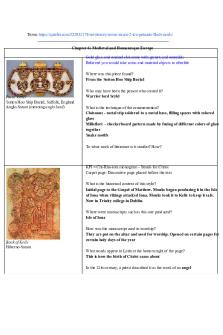Exam 2 study guide PDF

| Title | Exam 2 study guide |
|---|---|
| Course | Anatomy and Physiology I |
| Institution | Humber College |
| Pages | 1 |
| File Size | 58.6 KB |
| File Type | |
| Total Downloads | 22 |
| Total Views | 131 |
Summary
Summarized study guide for the second exam -> tissues/integumentary system...
Description
Human Anatomy & Physiology I Exam #2 Study Guide
Tissues 1. Know the general characteristics of epithelial tissue. 2. Be able to name the different types of epithelium, along with their locations & functions. 3. Know the basic characteristics of connective tissue. 4. Be able to name the different types of connective tissues, along with their locations & functions. 5. Know the cell types and matrix substance(s) of each connective tissue. 6. Know the basic characteristics of muscle and nervous tissue as covered in class. The Integumentary System 1. Know the various functions of skin. 2. Know the types of tissues associated with the epidermis, dermis, and hypodermis. 3. Know the layers of epidermis and characteristics of each. (i.e. only present in thick skin, top layer, site of keratinization, etc…) 4. Be able to list the major areas of the dermis and describe the characteristics of each. 5. Know the 3 pigments that play a role in skin color, their location, origin and color. 6. Know the general characteristics and products of the 4 glands covered in class. Be sure to know any important points stressed in lecture. (i.e. active at birth or active at puberty) 7. Be able to identify the layers of the hair and hair follicle; cortex, medulla, cuticle, inner root sheath, outer root sheath & connective tissue sheath. 8. Be able to identify the main parts of the nails. 9. Know the various skin disorders discussed in class. Bones & Skeletal Tissues 1. Be able to identify the different cartilages and location of each. 2. Know the definitions of intramembranous and appositional growth. 3. Know the parts of an osteon; know the microscopic differences between compact and spongy bone. 4. Know the basics of how bone tissue is formed, how bones grow in length & width, and bone remodeling. (Don’t stress over this one for hours, focus on the basic principle and any definitions covered during these sections); Know when, or under what conditions each occurs. 5. Be able to define the functions of osteocytes, osteoblasts and osteoclasts. 6. Know how hormones regulate the blood-calcium levels. 7. Describe the characteristics of the various bone disorders discussed in class....
Similar Free PDFs

Exam 2 Study Guide
- 32 Pages

Exam 2 Study Guide
- 5 Pages

Exam #2 Study Guide
- 4 Pages

Exam 2 study guide
- 29 Pages

Exam 2 Study Guide
- 71 Pages

Exam 2 Study Guide
- 2 Pages

Exam 2 Study Guide
- 24 Pages

EXAM 2 Study Guide
- 25 Pages

Exam 2 study guide
- 4 Pages

EXAM 2 study guide
- 5 Pages

Exam 2 Study Guide
- 11 Pages

Exam 2 Study Guide
- 10 Pages

Exam 2 Study Guide
- 6 Pages

Exam 2 Study Guide
- 17 Pages

Exam 2 Study Guide
- 3 Pages

EXAM 2 Study Guide
- 25 Pages
Popular Institutions
- Tinajero National High School - Annex
- Politeknik Caltex Riau
- Yokohama City University
- SGT University
- University of Al-Qadisiyah
- Divine Word College of Vigan
- Techniek College Rotterdam
- Universidade de Santiago
- Universiti Teknologi MARA Cawangan Johor Kampus Pasir Gudang
- Poltekkes Kemenkes Yogyakarta
- Baguio City National High School
- Colegio san marcos
- preparatoria uno
- Centro de Bachillerato Tecnológico Industrial y de Servicios No. 107
- Dalian Maritime University
- Quang Trung Secondary School
- Colegio Tecnológico en Informática
- Corporación Regional de Educación Superior
- Grupo CEDVA
- Dar Al Uloom University
- Centro de Estudios Preuniversitarios de la Universidad Nacional de Ingeniería
- 上智大学
- Aakash International School, Nuna Majara
- San Felipe Neri Catholic School
- Kang Chiao International School - New Taipei City
- Misamis Occidental National High School
- Institución Educativa Escuela Normal Juan Ladrilleros
- Kolehiyo ng Pantukan
- Batanes State College
- Instituto Continental
- Sekolah Menengah Kejuruan Kesehatan Kaltara (Tarakan)
- Colegio de La Inmaculada Concepcion - Cebu